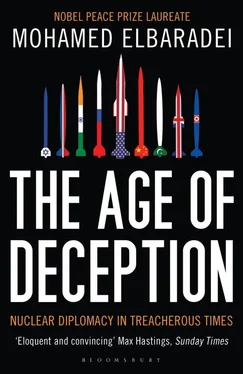Invariably, these accusations had political overtones, prompted as they usually were by the supportive or antagonistic relationship between the countries in question. This effort to enlist the Agency for partisan ends is amply illustrated by the evolution of five somewhat unusual encounters—with South Korea, Egypt, Israel, India, and Syria—and by some attempts to deal with the most extreme example of nuclear double standards: the lack of progress on nuclear disarmament.
In early 2004, South Korea began implementing its Additional Protocol. During an inspection that followed soon afterward, the IAEA discovered that experiments had taken place to separate very small amounts of plutonium. Follow-up investigations over the summer found that a few experiments had also involved enrichment of uranium. These activities had not been reported to the IAEA as required.
The South Korean government said it had been unaware of these experiments—they had been carried out by individual scientists at the Korean Atomic Energy Research Institute—and promptly took corrective action, firing staff and establishing a new oversight organization. Nevertheless, it was a huge embarrassment for the government, particularly in light of the ongoing tension regarding North Korea’s nuclear program.
The IAEA worked closely with the South Koreans to put the proper perspective on the news and prevent media hype. The Korean government, including Ban Ki-Moon, who was foreign minister at the time, appreciated our handling of the issue. But the slate was not yet clean: I was required to inform the IAEA Board of South Korea’s failure to report these nuclear activities to the Agency. The question was whether the Board would then deem that South Korea was in a state of “noncompliance.” And if so, would the Board then be obliged to report this noncompliance to the UN Security Council?
The issue of the IAEA Board’s obligation to report every noncompliance was the subject of a contentious debate between the Agency Secretariat and the EU-3, on the one hand, and the Americans, on the other. The Secretariat’s interpretation was that not every breach or violation of a country’s safeguards agreement rose to the level of “noncompliance” within the meaning of the Agency’s Statute. The IAEA Board enjoyed discretionary authority to exercise its judgment, to differentiate between cases that involved the diversion of nuclear material or clearly revealed a weapons program, such as Iraq before the first Gulf War—which might require action by the Security Council—and cases that showed no indication of sustained activity, such as South Korea, where a few scientists had conducted unreported laboratory-scale experiments out of scientific curiosity. But the Americans, especially in the case of Iran, insisted that the Board was obliged to report to the Security Council every breach or violation. The United States had pushed for referral to the council since my first report on Iran’s undeclared activities. The Europeans’ explicit agreement with the Secretariat’s interpretation was politically motivated: they wanted to use the prospect of referral to the Security Council as a whip with which to threaten Iran.
Now the defendant on the stand was South Korea, one of the “good guys,” a close ally as far as the United States was concerned. The Americans found themselves in a tricky spot. Sticking to their policy guns and referring South Korea to the Security Council for its reporting violations was contrary to the U.S. interest. For one thing, such action could well complicate negotiations with the North Koreans, who might try to use South Korea’s noncompliance as justification for their own nuclear activities. South Korea, I was told, was lobbying intensely in Washington against such a referral.
Thus, at the next IAEA Board meeting, the Americans declared that South Korea’s violation was not worth reporting to the Security Council. The Board’s action was merely “to take note of” my report. The entire incident vindicated and put a seal on the correctness of the Secretariat’s interpretation of how and when various degrees of noncompliance ought to be reported to the council—a judgment that contradicted the initial U.S. position of automatic referral, as the Americans were advocating in the case of Iran.
In Egypt, the IAEA encountered a similar case of undeclared nuclear experiments. As part of its ongoing assessment of a country’s nuclear file, the IAEA monitors relevant publications and other open sources for professional articles that might have a bearing on that state’s activities. In 2004, references in a number of such publications indicated that Egyptian scientists had conducted various types of experiments with nuclear material that had not been reported to the Agency.
The IAEA contacted the Egyptian Atomic Energy Authority, and a series of inspections ensued. The suspected R&D—scattered efforts related to uranium extraction and conversion, the irradiation of uranium and thorium targets in Egypt’s two research reactors, [1] In these types of experiments, a small “target” of one material is irradiated to produce another material. Thorium, like uranium and plutonium, is a nuclear material that can be used as fuel in a reactor. However, thorium itself cannot be used directly in a nuclear weapon, because it is not “fissile,” meaning that the thorium nucleus does not fission, or split, to produce energy. Instead, thorium is “fertile,” meaning that it can absorb neutrons to produce uranium-233, which in turn is a fissile material.
and reprocessing—had in fact occurred. In some cases the work had taken place in the 1980s. Egypt had failed to report to the IAEA both the activities and the small amount of nuclear material involved.
The problem appeared to be rooted in a lack of oversight and control, as well as in sloppiness and neglect. The facilities at the Inshas Nuclear Research Center, where some of these experiments took place, were run down; there were rooms that had not been opened in a decade and equipment worth millions of dollars that had never been used. I was told that the Egyptians had tried to delay the IAEA’s current inspections just to give themselves time to clean the place up. The head of Egypt’s Atomic Energy Agency, Aly Islam Metwally Aly, was not aware of some of the nuclear material and equipment in question, and he was plainly embarrassed. There was no indication that the country had a nuclear weapons program. Nonetheless, the Egyptian nuclear authorities did not come off looking very good.
My February 2005 update to the IAEA Board noted a series of reporting failures on Egypt’s part. Despite the small amounts of nuclear material used in the experiments and the openness of the Egyptian scientists in publishing their results in the scientific literature, these failures were a matter of concern and warranted investigation.
More than a year later, another nuclear issue came to the surface when, at a meeting of the ruling party, Mubarak’s son, Gamal, suggested that Egypt should develop a nuclear power program. The result was a frenzy of discussion and speculation. The Egyptian media made much of the issue: by advancing in nuclear science and technology, several pundits declared, Egypt would establish parity with Israel’s nuclear weapons program. The coverage by government-controlled media was a depressing mix of ignorance, frustration, and manipulation.
My first “official” discussion of the topic came in January 2007, in Algeria, where I happened to see the Egyptian minister of electricity and energy, Hassan Younes. Up to that point, the Egyptian government had not approached the IAEA for advice and expertise, a customary step for any country seeking to develop a nuclear power program. Younes told me that no decision had been made; Egypt was still conducting “studies.” He said they were working with a consultant, the American-owned Bechtel Corporation.
Читать дальше












